As a professional musician and teacher with over 15 years experiences, I understand how ear training is incredibly important for aspiring musicians. Without recognising musical ideas by hearing them, it can be tough to know how theoretical concepts, like intervals, relate to actual sounds. By understand what, and how to practice, you can greatly improve your musicality and appreciation of music. In short: it’s an essential skill.
So… let’s get into exactly what ear training is and how you can use it to level up your skills.
What is Ear Training?
- Ear training is learning how to strengthen the connection between concepts, such as ‘chords’, and the sounds we hear. This can be tough if you are listening to a complex piece of music with multiple instruments. So simple exercises are created to start learning these skills from the foundations up.
- You might have heard the term ‘aural training’ and this means the same thing as ‘ear training’.
Below is a typical ear training question. The piano will play two notes, and you will need to name the interval. This means how far away is the higher note from the lower one. Not sure what intervals are, check out our guide to intervals here.

Answer: The two notes were middle C and G, so the interval is a perfect 5th.
Who uses ear training?
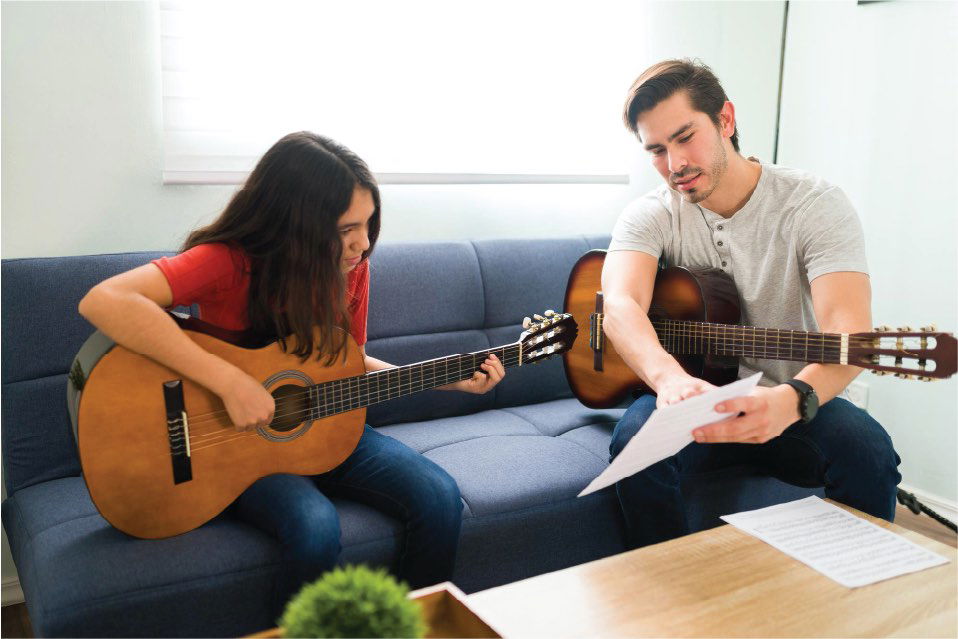
- Musicians use ear training to develop their overall musicality. Simply put; without being able to hear concepts like ‘intervals’ in music, it is hard to use them effectively in your playing or composing. Examinations, such as those from ABRSM, also have an aural component that students must take as part of their performance grades.
- Sound Engineers/ Music Producers other professionals working with sound use music training to develop their awareness of pitch, frequency and the mix of sounds.
What are the benefits of ear training?
For any music student there are lots of benefits to starting to develop your ear. You will see improvements in the following skills:
- The ability to sight read rhythms and melodies
- Improvisation
- Composition
- Being able to play with other musicians
- Be able to recognise the structure of pieces of music from listening to them
- Intonation – the ability to hit the correct pitch when playing an instrument
- Singing ability
Ear Training Exercises
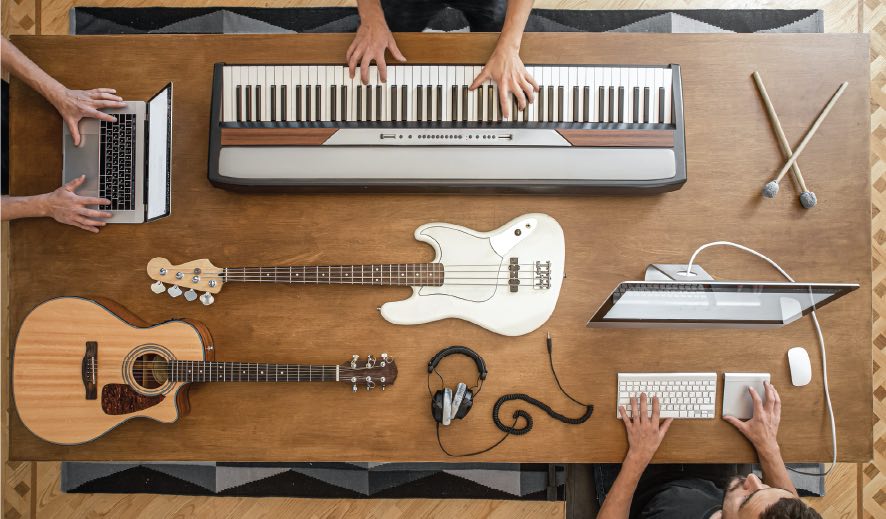
So ear training is useful for all kinds of musical things, but how can I train me ear? Ear training exercises have been created to develop the ear. They typically focus on one music theory concept and often involve recognising or singing back notes.
Pitch Exercises
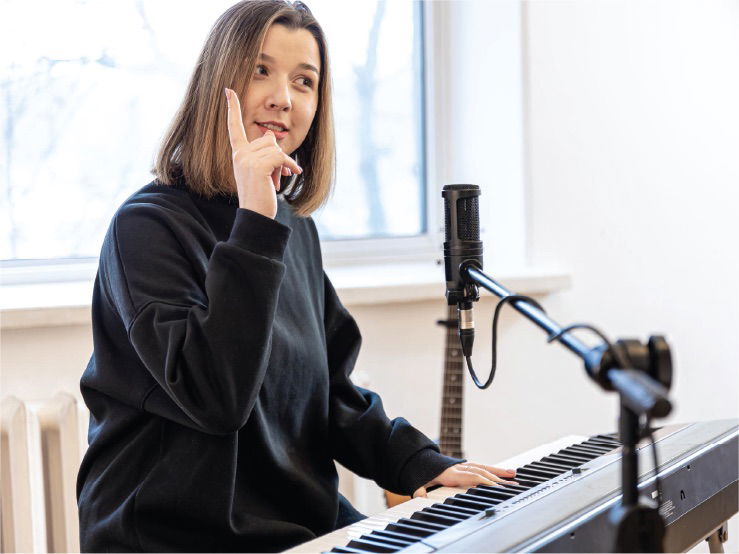
The pitch of a note is simply how high or low that note is. We can further break this down into what note name it has (C, C#, D etc.) and octave it is in. Each note has a fixed frequency and perfect pitch training is about learning to recognise these notes. If I play the A above middle C, can you recognise it?
Some people develop perfect pitch with more ease than others but it is important to remember that anyone can improve their ability to recognise and note single notes. Starting with a reference point, such as middle C, is a great way to start learning the absolute pitch of notes.
Relative pitch is a slightly more useful concept for musicians. If we are given two notes, can we say how much higher the top one is from the lower one? This could be measured in semitones or we could measure it by using the scale of the lower note. This could be called an interval (more on this in the intervals section).
Rhythm Exercises
Recognising time signatures and rhythms is an important part of ear training. A standard exercise would be to clap back a rhythm that is played, or to name the time signature of a short piece of music. Ear training can also be used to focus on more complex rhythmic ideas such as syncopation, polytrhyms and irregular time signatures.

Interval Exercises
As we mentioned in the ‘pitch’ section of ear training, intervals are a very important part of ear training. This is because they link many other areas, such as pitch, chords, scales and cadences. An interval a label for how far apart two notes are. We always start with the scale of the bottom note and then work out how far away to top note is. For more on this, see our complete guide to intervals.
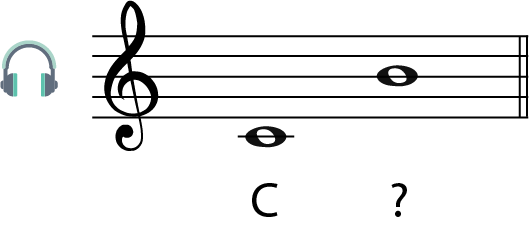
Answer: The second note is a B natural, so the interval is a Major 7th.
Scale Exercises
Knowing scales and the degrees of scales is an important musical concept. Ear Training exercises can focus on identifying types of scale after hearing them. The tonic note may be named to make the exercise easier or if the student wants to focus on naming types of scale (major, natural minor, melodic minor, harmonic minor, pentatonic etc.)
Students might also be asked to name the degree of the scale instead of the actual note note. This can be done using chord progressions:
- The student hears a short chord progression followed a single note.
- The student needs to identify the scale degree of the note relative to the key established by the chord progression.
This type of exercise can be considered ‘functional ear training’ because it is about orientated yourself within the key of the piece. This contrasts with ‘intervallic ear training’, which is about naming the distance between two notes.
Can you name the scale? Click here for the answer.
Chord Exercises
Recognising chords and chord progressions is another element of ear training that you’ll want to learn. Chords can be played and the listener asked to ‘name the chord’. (The individual notes could also be played as well as the complete chord.
Chord inversions may also be played and the listener will have to name the inversion and possibly the chord too.
Chord progressions are a sequence of chords that form the foundation of a piece of music. Can you recognise a chord progression by listening to it? Ear training will help you develop this ability.
Can you name the chord progression below? Click here for the answer.
Melodic Dictation
Melodic dictation is the skill of being able to listen to a melody and then quickly writing down the notes that comprise it. This combines ideas of intervals, pitch and scales with the ability to remember sequences of notes.
Listen to the melody below. Can you write down the notes in the treble clef? Click here for the answer.
What is perfect pitch?

Perfect pitch is ability to recognise notes from hearing them in isolation. For example, if I played the B above middle C on a piano, someone with perfect pitch could know that that is was ‘the B above middle C’. Essential they have committed to memory the frequency all the stand notes used in Western music.
This ability is reasonably rare and is usually found in children at around 6 years old (mostly from those with some form of musical training at this age). It is difficult to learn as an adult but I would argue, not that useful either.
The main thing that we want to cultivate is relative pitch rather than absolute pitch (perfect pitch). Music is made up of a sequence of notes and it is the relationship between these that we want to be about to hear. This is why you will rarely find ‘perfect pitch training’ in any traditional music programme or course.
Can ear training help you to develop perfect pitch?
You could use ear training to try to learn to recognise notes, without another note as a reference. However, I would say that this is not going to make you a better musician. Use ear training to learn relative pitch is far more useful. This is the ability to recognise a note when given a reference note, or to know the interval between two notes.
How do you practice ear training?
Traditionally Ear training has been taught during a students music lessons. Your piano teacher may place a note and ask you to sing the major 3rd above it. Or then might play a sequence of chords and ask you to name them. This way of ear training most definitely works but it is labour intensive, you need an expert there with you.
Many teachers find it hard to fit in the time for ear training as well as instrumental practice and music theory. It is also very difficult for a student practising on their own to know if their answers are correct.
To solve these issues number of apps have been developed to support students with ear training. These use software that can analyse the pitch of your voice, so see whether you are singing correct notes within an exercise. They also offer a range of different exercises and leaderboards, awards and other ‘game-like’ features to motivate students to keep up with their practice.
Ear training software
To solve these issues number of apps have been developed to support students with ear training. These use software that can analyse the pitch of your voice, so see whether you are singing correct notes within an exercise. They also offer a range of different exercises and leaderboards, awards and other ‘game-like’ features to motivate students to keep up with their practice. With ear training software you can train your ear through your phone or laptop.
ToneGym

ToneGym is a great place to start if you want an all-round app that will get you recognising scales and intervals in no time. See my review of ToneGym for more information.
How do I train my ears for piano?
Ear training does not change that much depending on the instrument you play. You will still need to recognise intervals, scales, chords and different meters. With the piano, a student may spend more time on chords than with single-note instruments such as the clarinet or saxophone.
How do I train my ears for guitar?
With the guitar you will need to know all the basic concepts that all musicians need: intervals, scales, chords and meters. Similar to the piano, the guitar can play chords, so a student would want this to form a large part of the training.
FAQs
Why is ear training so hard?
There are a couple of reasons why people can find ear training challenging:
- It’s not something you will have learnt elsewhere. Unless you are learning an instrument, you will not come across ear training at school in the workplace. This means students are often starting from scratch
- It is difficult to practice as traditionally you would need to do this during a music lesson. Luckily with apps this is becoming less of a problem.
- Like anything, it requires consistent practice over time to see results. Learning anything new takes a committment as it will take time for concepts to become embedding in your long term memory.
How often should you ear train?
The short answer is: it depends an a few things. How long is each practice session, how advanced are you with your music theory learning and what are your goals as a musician?
This being said, I recommend 2 or 3 times a week for my students, with each practise session lasting no more than 20 minutes. This gives enough time to see progress over a few weeks. I find that one students see (or hear!) themselves improving, they are some much more motivated to continue.
Answers
Scale
The answer is G Major.

Chords
The chords were E Minor, D Major and C Major.
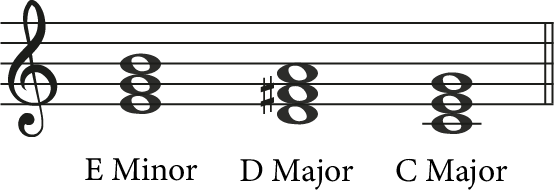
Melodic Dictation

